
Display examples
Encyclopedia
Over the years, a variety of display device
s and technologies have been used in order to display electronic data in a way that's legible to humans.
(CRT), which was made commercial in 1922. The CRT consists of an electron gun
that forms images by firing electrons onto a phosphor
-coated screen. The earliest CRTs were monochrome and were used primarily in oscilloscope
s and black and white televisions. The first commercial colour CRT was produced in 1954. CRTs were the single most popular display technology used in television set
s and computer monitors for over half a century; it was not until the 2000s that LCDs began to gradually replace them.
A derivative of CRTs were storage tube
s, which had the ability to retain information displayed on them, unlike standard CRTs which need to be refreshed periodically. In 1968, Tektronix
introduced the Direct-View Bistable Storage Tube, which went on to be widely used in oscilloscopes and computer terminal
s.
cathode ray tube
:

cathode ray tube
for the display of color television
:
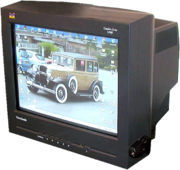
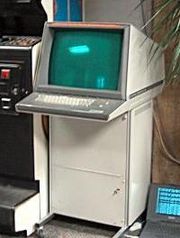
:
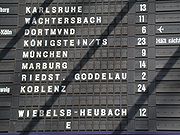
1961 Flip-disc display
:

plasma display
:

:


as used in consumer electronics.

LCD
:

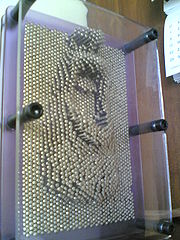
1969 Braille display:

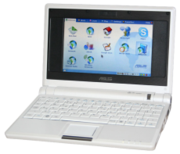
:

display (OLED)

2003 Active-matrix OLED
(AMOLED):
:
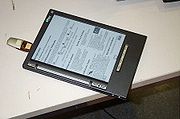
Display device
A display device is an output device for presentation of information in visual or tactile form...
s and technologies have been used in order to display electronic data in a way that's legible to humans.
Early history
One of the earliest electronic displays is the cathode ray tubeCathode ray tube
The cathode ray tube is a vacuum tube containing an electron gun and a fluorescent screen used to view images. It has a means to accelerate and deflect the electron beam onto the fluorescent screen to create the images. The image may represent electrical waveforms , pictures , radar targets and...
(CRT), which was made commercial in 1922. The CRT consists of an electron gun
Electron gun
An electron gun is an electrical component that produces an electron beam that has a precise kinetic energy and is most often used in television sets and computer displays which use cathode ray tube technology, as well as in other instruments, such as electron microscopes and particle...
that forms images by firing electrons onto a phosphor
Phosphor
A phosphor, most generally, is a substance that exhibits the phenomenon of luminescence. Somewhat confusingly, this includes both phosphorescent materials, which show a slow decay in brightness , and fluorescent materials, where the emission decay takes place over tens of nanoseconds...
-coated screen. The earliest CRTs were monochrome and were used primarily in oscilloscope
Oscilloscope
An oscilloscope is a type of electronic test instrument that allows observation of constantly varying signal voltages, usually as a two-dimensional graph of one or more electrical potential differences using the vertical or 'Y' axis, plotted as a function of time,...
s and black and white televisions. The first commercial colour CRT was produced in 1954. CRTs were the single most popular display technology used in television set
Television set
A television set is a device that combines a tuner, display, and speakers for the purpose of viewing television. Television sets became a popular consumer product after the Second World War, using vacuum tubes and cathode ray tube displays...
s and computer monitors for over half a century; it was not until the 2000s that LCDs began to gradually replace them.
A derivative of CRTs were storage tube
Storage tube
Mostly obsolete, a storage tube is a special monochromatic CRT whose screen has a kind of 'memory' : when a portion of the screen is illuminated by the CRT's electron gun, it stays lit until a screen erase command is given...
s, which had the ability to retain information displayed on them, unlike standard CRTs which need to be refreshed periodically. In 1968, Tektronix
Tektronix
Tektronix, Inc. is an American company best known for its test and measurement equipment such as oscilloscopes, logic analyzers, and video and mobile test protocol equipment. In November 2007, Tektronix became a subsidiary of Danaher Corporation....
introduced the Direct-View Bistable Storage Tube, which went on to be widely used in oscilloscopes and computer terminal
Computer terminal
A computer terminal is an electronic or electromechanical hardware device that is used for entering data into, and displaying data from, a computer or a computing system...
s.
Monochrome CRT
1922 MonochromeMonochrome
Monochrome describes paintings, drawings, design, or photographs in one color or shades of one color. A monochromatic object or image has colors in shades of limited colors or hues. Images using only shades of grey are called grayscale or black-and-white...
cathode ray tube
Cathode ray tube
The cathode ray tube is a vacuum tube containing an electron gun and a fluorescent screen used to view images. It has a means to accelerate and deflect the electron beam onto the fluorescent screen to create the images. The image may represent electrical waveforms , pictures , radar targets and...
:

Color CRT
1954 ColorColor
Color or colour is the visual perceptual property corresponding in humans to the categories called red, green, blue and others. Color derives from the spectrum of light interacting in the eye with the spectral sensitivities of the light receptors...
cathode ray tube
Cathode ray tube
The cathode ray tube is a vacuum tube containing an electron gun and a fluorescent screen used to view images. It has a means to accelerate and deflect the electron beam onto the fluorescent screen to create the images. The image may represent electrical waveforms , pictures , radar targets and...
for the display of color television
Color television
Color television is part of the history of television, the technology of television and practices associated with television's transmission of moving images in color video....
:

Direct-View Bistable Storage Tube
1968 The Direct-View Bistable Storage Tube CRT retains static information displayed upon it, written using a steerable electron beam that can be turned off. In principle the DVBST is similar to an Etch-a-Sketch, and was used in vector displays of early computers and in oscilloscopes.
Flip-flap/disc display
1957 Split-flap displaySplit-flap display
A split-flap display, sometimes simply flap display, is a display device that presents alphanumeric text, and possibly fixed graphics, often used as a public transport timetable in some airports or railway stations, often called Solari boards, named after display manufacturer Solari di...
:

1961 Flip-disc display
Flip-disc display
The flip-disc display is an electromechanical dot matrix display technology used for large outdoor signs, normally those that will be exposed to direct sunlight. Flip-disc technology has been used on buses across North America and Europe. It has also been used extensively on public information...
:

Monochrome plasma display
1964 MonochromeMonochrome
Monochrome describes paintings, drawings, design, or photographs in one color or shades of one color. A monochromatic object or image has colors in shades of limited colors or hues. Images using only shades of grey are called grayscale or black-and-white...
plasma display
Plasma display
A plasma display panel is a type of flat panel display common to large TV displays or larger. They are called "plasma" displays because the technology utilizes small cells containing electrically charged ionized gases, or what are in essence chambers more commonly known as fluorescent...
:

Light-emitting diode
1968 Light-emitting diodeLight-emitting diode
A light-emitting diode is a semiconductor light source. LEDs are used as indicator lamps in many devices and are increasingly used for other lighting...
:


Vacuum fluorescent display
1967 Vacuum fluorescent displayVacuum fluorescent display
A vacuum fluorescent display is a display device used commonly on consumer-electronics equipment such as video cassette recorders, car radios, and microwave ovens. Invented in Japan in 1967, the displays became common on calculators and other consumer electronics devices...
as used in consumer electronics.

Twisted nematic field effect LCD
1972 Twisted nematic field effectTwisted nematic field effect
The twisted nematic effect was a main technology breakthrough that made liquid crystal displays practical. Unlike earlier displays, TN-cells did not require a current to flow for operation and used low operating voltages suitable for use with batteries...
LCD
Liquid crystal display
A liquid crystal display is a flat panel display, electronic visual display, or video display that uses the light modulating properties of liquid crystals . LCs do not emit light directly....
:

Pin screen
Pin screen:
1969 Braille display:

Thin film transistor LCD
1986 Color Thin film transistor liquid crystal display:
Full-color plasma display
1995 Full-color plasma displayPlasma display
A plasma display panel is a type of flat panel display common to large TV displays or larger. They are called "plasma" displays because the technology utilizes small cells containing electrically charged ionized gases, or what are in essence chambers more commonly known as fluorescent...
:

Organic light-emitting diode
2003 Organic light-emitting diodeOrganic light-emitting diode
An OLED is a light-emitting diode in which the emissive electroluminescent layer is a film of organic compounds which emit light in response to an electric current. This layer of organic semiconductor material is situated between two electrodes...
display (OLED)

2003 Active-matrix OLED
Active-Matrix OLED
AMOLED is a display technology for use in mobile devices and televisions. OLED describes a specific type of thin-film display technology in which organic compounds form the electroluminescent material, and active matrix refers to the technology behind the addressing of pixels.As of 2011, AMOLED...
(AMOLED):
Electronic paper
2004 Electronic paperElectronic paper
Electronic paper, e-paper and electronic ink are a range of display technology which are designed to mimic the appearance of ordinary ink on paper. Unlike conventional backlit flat panel displays, electronic paper displays reflect light like ordinary paper...
:


